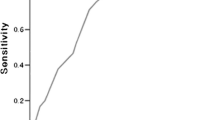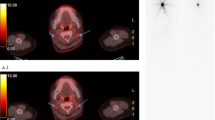Abstract
Background
We often observe that uptake of tracer is not detected in the primary cancer focus in patients with histologically proven papillary thyroid carcinoma (PTC) on preoperative 18F-fluorodeoxyglucose positron emission tomography-computed tomography (18F-FDG PET/CT). Therefore, we analyzed the clinical and pathologic variables affecting false-negative findings in primary tumors on preoperative 18F-FDG PET/CT.
Methods
We retrospectively reviewed the medical records of 115 consecutive patients who underwent 18F-FDG PET/CT for initial evaluation and were diagnosed with PTC by postoperative permanent biopsy. The clinical and pathologic characteristics that influence the 18F-FDG PET/CT findings in these patients were analyzed with respect to the following variables: age, gender, tumor size, multifocality of the primary tumor, perithyroidal invasion, lymphovascular or capsular invasion, and central lymph node metastasis-based final pathology.
Results
Twenty-six (22.6%) patients had false-negative 18F-FDG PET/CT findings. In patients with negative 18F-FDG PET/CT findings, tumor size, and perithyroidal and lymphovascular invasion were significantly less than in patients with positive 18F-FDG PET/CT findings. Tumors >1 cm in size were correlated with 18F-FDG PET/CT positivity. On multivariate analysis, perithyroidal invasion (P = 0.026, odds ratio = 7.714) and lymphovascular invasion (P = 0.036, odds ratio = 3.500) were independent factors for 18F-FDG PET/CT positivity. However, there were no significant differences between 18F-FDG PET/CT positivity and age, gender, capsular invasion, and central lymph node metastasis based on final pathology.
Conclusions
Tumor size and perithyroidal and lymphovascular invasion of papillary carcinoma can influence 18F-FDG PET/CT findings. Absence of perithyroidal and lymphovascular invasion were independent variables for false-negative findings on initial 18F-FDG PET/CT in patients with PTC.
Similar content being viewed by others
References
Pace L, Nicolai E, Klain M, et al. Diagnostic value of FDG PET/CT imaging. Q J Nucl Med Mol Imaging. 2009; 53(5):503–12.
Antoch G, Saoudi N, Kuehl H, et al. Accuracy of whole-body dual-modality fluorine-18-2-fluoro-2-deoxy-D-glucose positron emission tomography and computed tomography (FDG-PET/CT) for tumor staging in solid tumors: comparison with CT and PET. J Clin Oncol. 2004; 22(21):4357–68.
Bar-Shalom R, Yefremov N, Guralnik L, et al. Clinical performance of PET/CT in evaluation of cancer: additional value for diagnostic imaging and patient management. J Nucl Med. 2003; 44(8):1200–9.
Bertagna F, Bosio G, Biasiotto G, et al. F-18 FDG-PET/CT evaluation of patients with differentiated thyroid cancer with negative I-131 total body scan and high thyroglobulin level. Clin Nucl Med. 2009; 34(11):756–61.
Chung J, So Y, Lee J, et al. Value of FDG PET in papillary thyroid carcinoma with negative 131I whole-body scan. J Nucl Med 1999; 40(6):986.
Razfar A, Branstetter BFt, Christopoulos A, et al. 2010 Clinical usefulness of positron emission tomography-computed tomography in recurrent thyroid carcinoma. Arch Otolaryngol Head Neck Surg 136(2): 120–5.
Zuijdwijk MD, Vogel WV, Corstens FH, et al. Utility of fluorodeoxyglucose-PET in patients with differentiated thyroid carcinoma. Nucl Med Commun. 2008; 29(7):636–41.
Jeong HS, Chung M, Baek CH, et al. Can [18F]-fluorodeoxyglucose standardized uptake values of PET imaging predict pathologic extrathyroid invasion of thyroid papillary microcarcinomas? Laryngoscope. 2006; 116(12):2133–7.
Mitchell JC, Grant F, Evenson AR, et al. 2005 Preoperative evaluation of thyroid nodules with 18FDG-PET/CT. Surgery 138(6): 1166–74, discussion 1174–5.
Luster M, Karges W, Zeich K, et al. Clinical value of 18-fluorine-fluorodihydroxyphenylalanine positron emission tomography/computed tomography in the follow-up of medullary thyroid carcinoma. Thyroid. 2010; 20(5):527–33.
Esteva D, Muros MA, Llamas-Elvira JM, et al. Clinical and pathological factors related to 18F-FDG-PET positivity in the diagnosis of recurrence and/or metastasis in patients with differentiated thyroid cancer. Ann Surg Oncol. 2009; 16(7):2006–13.
Cooper DS, Doherty GM, Haugen BR, et al. Revised American Thyroid Association management guidelines for patients with thyroid nodules and differentiated thyroid cancer. Thyroid. 2009; 19(11):1167–214.
NCCN. NCCN Clinical Practive Guidelines in Oncology: thyroid carcinoma Available: http://www.nccn.org/professionals/physician_gls/PDF/thyroid.pdf. Accessed 14 Oct 2010.
Gharib H, Papini E, Paschke R, et al. American association of clinical endocrinologists, Associazione Medici Endocrinologi, and European thyroid association medical guidelines for clinical practice for the diagnosis and management of thyroid nodules: executive summary of recommendations. Endocr Pract. 2010; 16(3):468–75.
Giammarile F, Hafdi Z, Bournaud C, et al. Is [18F]-2-fluoro-2-deoxy-d-glucose (FDG) scintigraphy with non-dedicated positron emission tomography useful in the diagnostic management of suspected metastatic thyroid carcinoma in patients with no detectable radioiodine uptake? Eur J Endocrinol. 2003; 149(4):293–300.
Menzel C, Zaplatnikov K, Diehl M, et al. The influence of thyroglobulin on functional imaging in differentiated thyroid cancer. Nucl Med Commun. 2004; 25(3):239–43.
Schluter B, Bohuslavizki KH, Beyer W, et al. Impact of FDG PET on patients with differentiated thyroid cancer who present with elevated thyroglobulin and negative 131I scan. J Nucl Med. 2001; 42(1):71–6.
Puxeddu E, Filetti S. The 2009 American thyroid association guidelines for management of thyroid nodules and differentiated thyroid cancer: progress on the road from consensus-to evidence-based practice. Thyroid. 2009; 19(11):1145–7.
Tuttle RM, Leboeuf R, Martorella AJ. Papillary thyroid cancer: monitoring and therapy. Endocrinol Metab Clin North Am. 2007; 36(3):753–78, vii.
Acknowledgment
This study was supported by a grant from the National R&D Program for Cancer Control, Ministry for Health, Welfare, and Family Affairs, Republic of Korea (0720560).
Author information
Authors and Affiliations
Corresponding author
Rights and permissions
About this article
Cite this article
Choi, J.W., Yoon, Y.H., Yoon, Y.H. et al. Characteristics of Primary Papillary Thyroid Carcinoma with False-Negative Findings on Initial 18F-FDG PET/CT. Ann Surg Oncol 18, 1306–1311 (2011). https://doi.org/10.1245/s10434-010-1469-2
Received:
Published:
Issue Date:
DOI: https://doi.org/10.1245/s10434-010-1469-2




